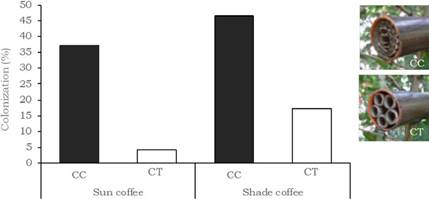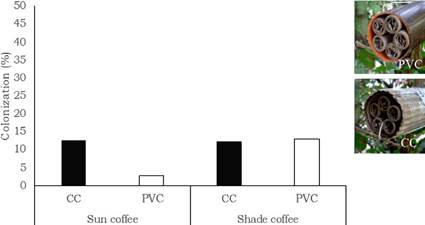Introduction
Coffee crop intensification often involves elimination of associated trees and high agrochemical use, practices which negatively affect the natural diversity associated to the plantations (Armbrecht & Perfecto, 2003). Traditionally, coffee was planted under a canopy of native trees which protected the plants and soil, and provided habitat for wild fauna such as birds, mammals, and insects. However, some decades ago, a fast conversion and intensive production system was implemented with no tree cover and was highly dependent on agricultural inputs (Perfecto et al., 1996). In Colombia, more than half of the coffee agroecosystems have no shade trees (Jha et al., 2014; Ocampo-Lopez & Alvarez-Herrera, 2017). This reduction of shade affects the structural complexity of the coffee agroecosystem with negative consequences for the associated biodiversity and its ecosystem services (De La Mora et al., 2015; Philpott & Armbrecht, 2006).
The lack of shade trees limits the amount of available resources that ants need for nesting (less leaf litter, twigs and trunks) (Armbrecht et al., 2006), thus probably reducing their impact on biological pest control (Philpott & Armbrecht, 2006). As an alternative, the provision of artificial nesting sites could contribute to an increase in abundance of ants that nest in twigs on shrubs and, therefore, promote both the abundance and diversity of ants, and a more effective biological control of pests on the sites where the artificial nests are located (Guzman et al., 1997; Vidal-Hernández & Armbrecht, 2009; Hosang et al., 2010; De la Mora et al., 2015). For instance, Guzman et al. (1997) found 98% control by ants of a pest in oil palms whereas Crematogaster sp. was promoted while Vidal-Hernandez and Armbrecht (2009) found increased ant diversity when bamboo twigs were added to Colombian coffee plantations. Hosang et al. (2010) managed to enhance the predator ant Dolichoderus thoracicus using artificial nesting substrates while De la Mora et al. (2015) found that prey removal by ants on coffee plantations was positively correlated with hollow coffee twigs. Further, heterogeneous nesting resources (substrates) could be important in promoting ant diversity and abundance (Armbrecht et al. 2004; Mottl et al., 2019) Given these studies and the potential of ants as biocontrol agents, an assessment is needed for the type of substrates or the appropriate configurations required to favour ant colonization in a given agroecosystem.
In this study, a total of three field tests were performed in order to assess nesting ability, preferences and colonization rates of ant species in both shaded-grown and sun-grown coffee crops, when artificial nesting resources were provided in plantations in southwestern Colombia. First, we tested ant colonization in two different designs of artificial substrate. Based on the best traits of those designs, a third nesting substrate was designed and monitored for ant colonization over time. We hypothesized that the presence of trees in coffee plantations fosters the colonization of artificial substrates by generalist ants, and that a higher percentage of substrates will be colonized by ants over time.
Methods
Study area
The sampling site was located in the village of La Venta, Municipality of Cajibio, Cauca Department, Colombia (2°37′24″N; 76°34′23″W). The site was located in the Alto Cauca Valley at 1,760 m.a.s.l. with annual temperatures between 23.8-27.1°C (IDEAM 2015). Three sun-grown and three shade-grown coffee plantations were selected, approximately 1.5 ha each, with (3-year-old coffee shrubs planted 1.5-2.0 m from each other (Table S1). To differentiate shade-grown from sun-grown coffee plantations, the canopy cover was calculated by means of a GRS Densitometer(TM) at 400 observation points. Canopy cover was 6.2% ((9.5; n=3) in sun-grown coffee vs. 42.3% ((6.5; n=3) in shade-grown coffee. Three independent tests were performed between 24 March and 18 December 2015 on all six plots at different moments. During the sampling period, monthly temperature and average precipitation data were recorded (Figure 1) (IDEAM, 2015). The first test matched a decrease in precipitation, the second was made throughout the dry period, and the third during a transition to the next rainy season. Each of the three tests carried out in the field is described below.
Sampling period
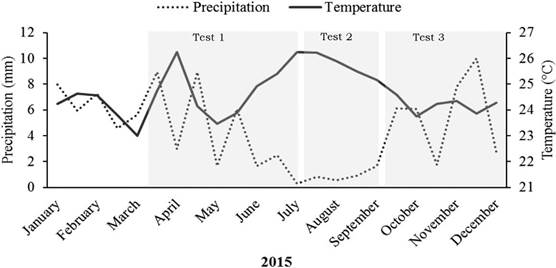
Figure 1 Monthly temperature in °C (black line) and monthly precipitation in mm (dotted line) recorded during 2015, the year when the three independent experiments were performed (Source: IDEAM Colombia).
Test 1: PVC covers filled with corrugated cardboard (CC) vs. cardboard tubes (CT)
Ant nesting was compared in two types of artificial substrates: polyvinylchloride tubes filled with corrugated cardboard (CC) vs. polyvinylchloride tubes filled with cardboard tubes (CT), on sun-grown and shade-grown coffee plantations (Figure 2a). The CC resembles the cavities found in tree bark where ants forage and nest, and CT resembles hollow twigs. The PVC cover was a tube 6 cm in diameter and 30 cm in length. The CC substrate filling consisted of a 30 × 46 cm sheet of a tightly rolled CC, forming internal cavities of 0.3cm in diameter and 0.4 cm in height (Packing S.A., Colombia). The CT substrate consisted of five firmly packed CT (diameter = 1 cm, length = 30 cm, thickness = 3-4 mm) (Figure 2a). On each of the six coffee plantations, 20 focal units of trees with high ant activity were identified. Then, two CC substrates and two CT substrates were placed on four coffee plants surrounding the tree (Figure 2a). Overall, 120 artificial substrates were provided: 60 on shade-grown coffee plots and 60 on sun-grown coffee plots. Substrates were installed from March 21st to 24th, 2015 (flowering cycle), and collected between June 28th and July 3rd (fruiting cycle) after three months for inspection to assess colonization.
Test 2: Cover comparison (PVC vs. CC)
Given the possibility of a ‘greenhouse effect’ on the interior of the substrates caused by a polyvinylchloride cover, a second test was performed in sun-grown and shade-grown coffee to establish whether this type of cover affected substrate colonization. For this test, we compared ant nesting in substrates with two different covers: polyvinylchloride tube vs. CC covered with a transparent plastic film (Figure 2b). Both covers were filled with the same substrate consisting of CT filled with CC. The same six coffee plots in Test 1 were used for Test 2. In each coffee plot, 13 pairs of contiguous coffee trees with high ant activity were selected, and the two types of substrates were randomly assigned to each coffee tree. A total of 156 artificial substrates were used in this test: 78 on shade-grown coffee plots and 78 on sun-grown coffee plots. Inner substrate temperature was estimated for sun-grown and shade-grown coffee from a total of 30 substrates of each type. The substrates were installed between June 28th and July 3rd, 2015 during the fruiting cycle and were collected, uncovered, and inspected between September 12th and 15th, 2015 (flowering cycle) to assess ant colonization after two months.
Test 3. Single type of a full cardboard substrate: colonization over time
In this test, a single substrate type was monitored for ant colonization over time in sun-grown and shade-grown coffee. Based on previous experience with Tests 1 and 2, we designed a substrate covered by CC (to avoid an increase in internal temperature) and filled it with a combination of CT and CC (to allow nesting by ants of different sizes) (Figure 2c). Specifically, the filling of each substrate consisted of five flattened and tightly packaged CT (diameter = 3 mm; length = 30 cm), protected by a CC cover (30 × 36 cm) and wrapped in a transparent plastic film (Figure 2c). At each coffee plot, 40 artificial substrates were fixed (one substrate per coffee plant) and spatially distributed into five rows, each of them containing eight substrates separated from each other by ten coffee plants. A total of 240 substrates were provided: 120 in sun-grown coffee and 120 in shade-grown coffee. Substrates were checked once a month for three months for ant colonization. Substrates were installed between September 12th and 15th, 2015 (flowering cycle), collected between December 15th and 18th, 2015 (fruiting period). Identification of the ants nesting in the substrates was performed using available guides on Neotropical ants: Fernández and Palacio (2003), Antweb (2014), and Longino (2003). Cephalic capsules were measured for twenty individuals from each nesting species using a SMZ 645 model Nikon stereoscope with magnifying binocular lenses up to 8.0 × (4.0 × 2.0).
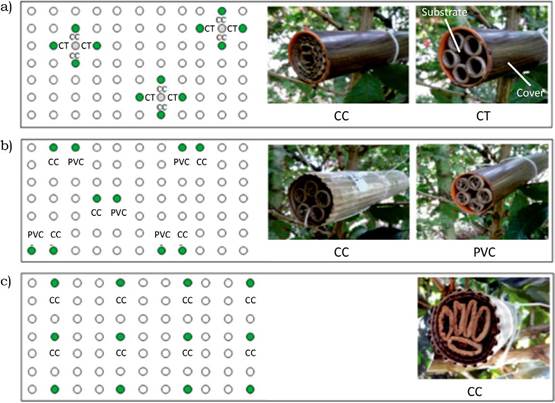
Figure 2 Types of artificial substrates offered and their allocation within the coffee plantation: a) In Test 1, a PVC cover with two types of filling substrate (CC and CT) was placed around trees with high ant activity; b) for Test 2, two different types of covers (PVC vs. CC) for the same substrate filling (CT filled with CC) were compared; c) in Test 3, a single type of substrate made of CC was evenly distributed in the plantations.
Data analyses
For the three tests, colonization percentages were estimated as number of colonized substrates over the total of recovered substrates (missing substrates were not considered) and analysed in relation to substrate type and tree cover on the coffee plots.
In Test 1, a generalized linear mixed model (GLMM) was used to assess the effect of substrate type, coffee plot, tree cover type (fixed factors) and focal unit (random factor) on the colonization percentage by ants. The response variable was binary. Only those focal units where at least one substrate of each type was recovered were used. Through this model, we assessed possible interactions between type of substrate and type of arboreal cover.
In Test 2, no statistical analysis was carried out because the independence of the sample units could not be clearly established. Therefore, a descriptive comparison of the treatments was made. The inner substrate temperatures on sun-grown and shade-grown coffee plantations were compared using a t-student test.
For Test 3, a chi-square test (Zar, 1999) was used to determine if differences existed in the proportion of colonized substrates between sun-grown and shade-grown coffee during the months of substrate monitoring. For the GLMM and chi-square tests, we used the glmer package from the Ime4 library and R Studio software (R Core Team, 2013). For this test, each coffee plantation was considered a sample unit. Colonization preferences by ant species on the different tests were also analysed
Analyses and results
Test 1: Substrate comparison (CC vs. CT)
General colonization in the first test was 28.9%. Substrate colonization was not significantly affected by the presence of tree cover on the coffee plantation (F (1.52) = 0.47; p = 0.49). No interaction between type of tree cover and type of substrate was found, indicating that tree cover had no influence on the success of substrate colonization (F (4.52) = 1.4162; p = 0.7081). However, ants showed a nesting preference for the substrate filled with CC compared to CT on both sun-grown and shade-grown coffee plantations (F (1.52) = 6.45; p = 0.014) (Figure 3). The species with the highest number of colonization events were Nesomyrmex asper (52.6% in shade-grown coffee and 36.4% in sun-grown coffee) and Crematogaster crinosa (54.5% in sun-grown coffee but only 10.5% in shade-grown coffee). Both species nested exclusively inside substrates filled with CC (Supplementary material, Figure S1) and had the smallest cephalic capsules among all the ants found in this experiment (Table 1). Larger Camponotus species were found nesting exclusively inside the CT. The reason for including a measurement of cephalic capsules was because a trend for smaller species nesting in corrugated cardboard was detected. However, there was not enough data to test for differences in ant traits according to substrate features. Barroso et al. (2020), in Brazil, found that different species of Pheidole colonized twigs with different wood anatomy and structure, which suggests that wood structure determines preference for twig occupation.
Table 1 Size of cephalic capsule of ants nesting in Test 1 substrates, and size of entrance to their respective substrate. Average values ±SD are presented in this table. N = 20 workers for all species listed.
| Species | Approx. size of head (mm) | Size of entrance to substrate (mm) |
|---|---|---|
| Crematogaster crinosa | 0.8 (± 0.07) | 4 |
| Cr. montezumia | 0.74 (± 0.09) | 4 |
| Nesomyrmex asper | 1.16 (± 0.11) | 4 |
| Camponotus sp. 1 | 2.5 (± 0.29) | 10 |
| Camponotus sp. 2 | 2.38 (± 0.47) | 10 |
| Camponotus cf. indianus | 5.1 (± 1.58) | 10 |
Test 1
Test 2: Cover comparison (corrugated cover vs. PVC cover)
A general colonization of 9.9% was found, the lowest among all the tests (Figure 4), which coincided with the driest/hottest period in the study (Figure 1). However, this coincidence does not necessarily explain the observed nesting preferences. Ant colonization was 7.5% in sun-grown coffee and 12.5% in shade-grown coffee. In sun-grown coffee, a higher colonization percentage was found in CC (12.5% for CC vs 2.9% for PVC), while in shade-grown coffee a similar colonization by ants was found in both substrates (12.1% in CC and 12.9% in PVC). In general, average inner temperature was 2.3-2.7(C higher in sun-grown coffee than in shade-grown coffee. In sun-grown coffee, temperature inside substrates covered with PVC (27.0(C) was higher than substrates covered by CC (26.6(C) (t (14) = -2.28; p = 0.0298); in contrast, substrates on shade-grown plantations showed no differences (t (14) = 0.183; p = 0.855). Due to the low number of colonized substrates, the colonization preferences by ants are difficult to detect. Again, N. asper colonized more substrates in sun-grown and shade-grown coffee (Figure S2). Temperatures inside PVC substrates were only significantly higher than those inside CC substrates on sun-grown coffee plantations (Table S2) in contrast to shade-grown coffee where no differences were detected. In shade-grown coffee, the different ant species indistinctively colonized substrates with both cover types. However, in sun-grown coffee, N. asper never colonized substrates covered with PVC, suggesting a species-specific thermal response to the increased inner temperature due to the PVC cover on plots with low tree cover.
Test 2
Test 3. Monitoring of a type of artificial substrate over time
General colonization showed no significant variation over time (χ 2 (1) = 0.14; p = 0.71). Colonization percentages per month were 13.6%, 14.1%, and 17.5% for the first, second, and third month, respectively (Figure 5). Colonization was higher in shade-grown coffee (χ 2 (1) = 32.85; p = 0.95*e -9) and a trend towards an increase in colonization was observed as time passed (from 18% to 25%). On sun-grown coffee plantations, colonization remained relatively stable over time (6% to 8%). Species N. asper, C. crinosa and Camponotus sp.1 were found in both sun-grown and shade-grown coffee (Figure S3). N. asper colonized a higher number of substrates in this test, showing the highest colonization percentage in shade-grown coffee, followed by C. crinosa.
Test 3
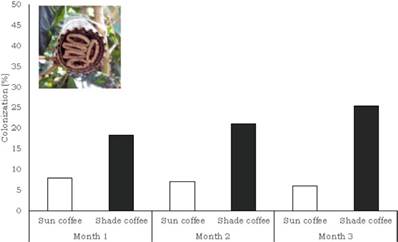
Figure 5 Percentage of ant colonization on shade-grown and sun-grown coffee plantations over a three-month period in Test 3. The substrate was mainly made of corrugated cardboard (CC). An increase in the colonization of shade-grown coffee plantations was observed over time, whereas colonization remained stable on the sun-grown coffee plantations.
Discussion
In general, this research project shows that arboreal generalist ants do use artificial substrates mainly made of recyclable cardboard as an alternative nesting resource on both sun-grown and shade-grown coffee plantations. Low colonization percentages also occurred in the same region where Vidal-Hernandez and Armbrecht (2009) found colonization values of 13.24% and 6.03% in artificially added bamboo twigs both in shade-grown and sun-grown coffee, respectively. The percentage of colonization was low compared to other studies (Hosang et al., 2010; Mottl et al. 2019), possibly due to a reduction in ant diversity and abundance with elevation (Lach et al., 2010). Although ants are found on almost all continents (except Antarctica), they are mainly found at low latitudes and, in general, there is a monotonal reduction of ant richness with altitude (Fisher, 2010). Ants are also sensitive to environmental conditions (Fisher, 2010). The general low ant nesting activity may also be explained by the extraordinarily dry conditions during the test period which coincided with the lowest colonization rates experienced in Test 2. This test occurred during the driest season of the year, from July to September, when higher temperatures and lower precipitation were recorded. Such environmental conditions may have affected the ants, since they are sensitive to microhabitat conditions (Perfecto and Vandermeer, 1996) Furthermore, the noteworthy colonization by other arthropods (mainly Araneae, Hymenoptera; Crabronidae, and Blattodea. See Table S3) during the dry season may have fostered interspecific competition for the artificial substrates.
Substrate materials and their configuration affected colonization by ants. Although we could not prove a relationship between ant size and substrate configuration, it is possible that the smaller entrances in CC filtered certain ant species; therefore, smaller ants like N. asper and C. crinosa were more capable of nesting in this substrate, while larger ant Camponotus species preferred CT with larger entrances. Possibly, arboreal ants such as N. asper and C. crinosa preferred CC because they closely resembled their natural nesting habitats in cavities in branches and bark (Tschinkel, 2002; Longino, 2003), while Camponotus are found nesting in hollow twigs from living and dead tree branches (Longino, 2006; Yamamoto & Del Claro, 2008). Therefore, providing more heterogeneous substrates may allow for greater diversity due to niche differentiation in the ant community colonizing the artificial substrates, as suggested by Jimenez-Soto and Philpott (2015).
Despite a trend towards increasing species richness among ants nesting in shade-grown coffee in Test 1 and 2, no solid evidence was found that crop management type influenced substrate colonization or the number of ant species that colonized. One would expect colonization of artificial substrates to be higher in sun-grown coffee, where nesting resources for ants are scarce, as suggested by Armbrecht et al. (2006) and Philpott and Foster (2005). However, in this study, the most abundant and frequent species present in both sun-grown and shade-grown coffee (also found by Escobar et al., 2020, using tuna bait at the same study site) did not necessarily colonize the substrates, suggesting that colonization was more related to idiosyncratic preferences of a small-sized ant species present on both types of coffee plantations. Thus, the dominance of N. asper, Crematogaster crinosa and Camponotus sp. 1 colonizing substrates in both types of coffee plantations explained the lack of differences between sun-grown and shade-grown coffee. Philpott and Foster (2005) found that Nesomyrmex sp. showed the greatest colonization (219 colonization events) of artificial substrates on shade-grown coffee plantations in Mexico.
No differences in internal temperatures were found between substrate types in shade-grown coffee (in Test 2) while statistical differences were actually detected between substrates in sun-grown coffee. This suggests that the temperature in PVC substrates in sun-grown coffee could be limiting the ability of ants to colonize, since ants in sun-grown coffee mainly colonized substrates with no PVC cover. The presence of tree cover may have buffered the effects of hot days and low precipitation, sustaining microclimatic conditions suitable for ant nesting in any type of substrate.
Results from Test 3 showed an increase in substrate colonization over time in shade-grown, but not sun-grown, coffee. This suggests that the positive effects from adding artificial substrates is better in shade-grown coffee and is consistent with Armbrecht et al. (2006) and Philpott and Foster (2005), who found greater limitation for twig-nesting ants on sun-grown coffee plantations in Colombia and Mexico, respectively.
Conclusions
The three questions initially asked were answered in this study. Ants nested in artificial substrates; their nesting was slightly higher in corrugated cardboard (CC) and in shade-grown coffee, and increased over time. The provision of artificial substrates made with cardboard might help increase the number of colonization events, and possibly enhance biocontrol of the coffee berry borer bug (Hypothenemus hampei, Coleoptera: Curculionidae) by ants, as nesting ants of the genera Nesomyrmex and Crematogaster have been reported as natural enemies of this important pest. In order to increase nesting activity and potential pest control services on coffee plantation, we suggest combining CC with materials that provide diverse entrance sizes and configurational heterogeneity. Carefully choosing a protecting wrap for the substrates will be important on sun-grown coffee plantations during the dry season as microclimatic conditions cannot be buffered by the presence of a shade trees. Therefore, the use of PVC as a substrate cover should be avoided on sun-grown coffee plantations. Installation of artificial substrates during the rainy season is highly recommended.
Author contribution statement
The total contribution percentage for the conceptualization, preparation, and correction of this paper was as follows: A.J.L.D. 34 %., S.E.R. 33 % and I.A. 33 %.
Data availability statement
The data supporting the results of this study will be made available by the corresponding author, Armbrecht, I., upon reasonable request.














